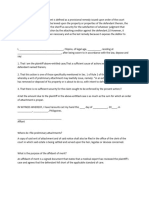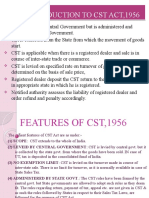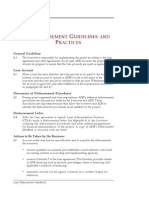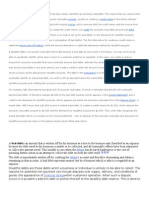Bad Debt
Bad Debt
Uploaded by
Tran Minh KhoiCopyright:
Available Formats
Bad Debt
Bad Debt
Uploaded by
Tran Minh KhoiOriginal Description:
Original Title
Copyright
Available Formats
Share this document
Did you find this document useful?
Is this content inappropriate?
Copyright:
Available Formats
Bad Debt
Bad Debt
Uploaded by
Tran Minh KhoiCopyright:
Available Formats
Bad debt
Bad debt
A bad debt is an amount owed to a business or individual that is written off by the creditor as a loss (and classified as an expense) because the debt cannot be collected and all reasonable efforts to collect it have been exhausted. This usually occurs when the debtor has declared bankruptcy or the cost of pursuing further action in an attempt to collect the debt exceeds the debt itself. [1] [2] [3] The debt is immediately written off by crediting the debtor's account, eliminating any balance remaining there. The crediting represents a loss to the creditor.
Doubtful debt
Doubtful debts are those debts which a business or individual is unlikely to be able to collect. The reasons for potential non-payment can include disputes over supply, delivery, the condition of item or the appearance of financial stress within a customer's operations. When such a dispute occurs it is prudent to add this debt or portion thereof to the doubtful debt reserve. This is done to avoid over-stating the assets of the business as trade debtors are reported net of Doubtful debt. When there is no longer any doubt that a debt is uncollectible, the debt becomes bad. An example of a debt becoming uncollectible would be:- once final payments have been made from the liquidation of a customer's limited liability company, no further action can be taken.
Doubtful debt reserve
Also known as a bad debt reserve, this is a contra account listed within the current asset section of the balance sheet. The doubtful debt reserve holds a sum of money to allow a reduction in the accounts receivable ledger due to non-collection of debts. This can also be referred to as an allowance for bad debts. Once a doubtful debt becomes uncollectable, the amount will be written off.
US accounting practice
Allowance for bad debts are amounts expected to be uncollected, but still with possibilities of being collected (when there is no other possibility for them to be collected, they are considered as uncollectible accounts). For example, if gross receivables are $100,000 and the amount that is expected to remain uncollected is $5,000, net current asset section of balance sheet will be:
Gross accounts receivable Less: Allowance for bad debts Net receivables $100,000 $5,000 $95,000
In financial accounting and finance, bad debt is the portion of receivables that can no longer be collected, typically from accounts receivable or loans. Bad debt in accounting is considered an expense. There are two methods to account for bad debt: 1. Direct write off method (Non-GAAP) - a receivable which is not considered collectible is charged directly to the income statement. 2. Allowance method (GAAP) - an estimate is made at the end of each fiscal year of the amount of bad debt. This is then accumulated in a provision which is then used to reduce specific receivable accounts as and when necessary. Because of the matching principle of accounting, revenues and expenses should be recorded in the period in which they are incurred. When a sale is made on account, revenue is recorded along with account receivable. Because there is an inherent risk that clients might default on payment, accounts receivable have to be recorded at net realizable
Bad debt value. The portion of the account receivable that is estimated to be not collectible is set aside in a contra-asset account called Allowance for doubtful Accounts. At the end of each accounting cycle, adjusting entries are made to charge uncollectible receivable as expense. The actual amount of uncollectible receivable is written off as an expense from Allowance for doubtful accounts.
Taxability
Some types of bad debts, whether business or nonbusiness related, are considered tax deductible. Section 166 of the Internal Revenue Code provides the requirements which for a bad debt to be deducted.[4]
Criteria for deduction
To be considered as deductible, the debt must be: bona fide debt, and worthless within the taxable year. A debt is defined as a debt which arises from a debtor-creditor relationship based upon a valid and enforceable obligation to pay a determinable sum of money. The debt in question must also be considered worthless. This distinction is further broken down into the level of collectibles. One must determine whether the qualifying debt is completely or partially worthless. A partially worthless status means a portion of the debt may be recovered in future periods. Numerous factors are taken into consideration including the debtors insolvency status, health conditions, credit standing, etc.[5]
Section 166
Section 166 limits the amount of the deduction. There must be an amount of tax capital, or basis, in question to be recovered. In other words, is there an adjusted basis for determining a gain or loss for the debt in question. An additional factor in applying the criteria is the classification of the debt (nonbusiness or business). A business bad debt is defined as a debt created or acquired in connection with a trade or business of the taxpayer. Whereas, a nonbusiness debt is defined as a debt that is not created or acquired in connection with a trade or business of the taxpayer. The classification is quite significant in terms of the deductibility. A nonbusiness bad debt must be completely worthless in order to be deducted. However, a business bad debt is deductible whether it is partially or completely worthless.
Mortgage Bad Debt
Mortgages which may become noncollectable can be written off as a bad debt as well. However, they fall under a slightly different set of rules. As stated above, they can only be written off against tax capital, or income, but they are limited to a deduction of $3,000 per year. Any loss above that can be carried over to following years at the same amount. Thus a $60,000 mortgage bad debt will take 20 years to write off.[6] Most owners of junior (2nd, 3rd, etc.) fall into this when the 1st mortgage forecloses with no equity remaining to pay on the junior liens. There is one option available for mortgages not available for business debt - donation. The difference is that a valuation of $10,000 can be taken without an appraisal. An appraisal may be able to increase the value to more and must be based on other similar mortgages that actually sold, but generally is less than the face value. The real difference is that as a donation the amount of deduction is limited to up to 50% of Adjusted Gross Income per year with carryovers taken over the next 5 years .[7] This is because the deduction is now classified as a donation instead of a bad debt write off and uses Schedule A instead of Schedule D
Bad debt .[6] This can significantly increase current year's tax reductions compared to the simple write off. The caveat is that it must be completed PRIOR to the date of final foreclosure and loss. The process is simple, but finding a charity to cooperate is difficult since there will be no cash value as soon as the 1st mortgage forecloses.
References
[1] [2] [3] [4] http:/ / www. apm. com. au/ osbuyers/ glossary. htm http:/ / www. allbusiness. co http:/ / financial-dictionary. thefreedictionary. com/ Bad+ Debt TaxAlmanac - Internal Revenue Code:Sec. 166. Bad debts (http:/ / www. taxalmanac. org/ index. php/ Internal_Revenue_Code:Sec. _166. _Bad_debts) [5] Tax Topics - Topic 453 Bad Debt Deduction (http:/ / www. irs. gov/ taxtopics/ tc453. html) [6] Form 1040, IRS Instructions for Schedule A (Form 1040) (http:/ / www. irs. gov/ pub/ irs-pdf/ i1040sd. pdf) [7] Pub.526, Publication 526 Charitable Contributions (http:/ / www. irs. gov/ pub/ irs-pdf/ p526. pdf)
External links
Bad Debts (http://www.svtuition.org/2009/11/how-to-teach-concept-of-debtors-bad.html) NYSSCPA's glossary (http://www.nysscpa.org/glossary) of accounting terms
Article Sources and Contributors
Article Sources and Contributors
Bad debt Source: http://en.wikipedia.org/w/index.php?oldid=540378273 Contributors: -1g, AngieYoda, AnthonyUK, AxelBoldt, Busy Stubber, Can't sleep, clown will eat me, Charles Matthews, Correogsk, Cpsilva, Drkenrich, Eastlaw, ElationAviation, Fistiquette, Fuhghettaboutit, Green Squares, GreyWyvern, Guinevere19, Haltiamieli, Heyzeuss, Hi878, ItsZippy, Itsjustajoy, Jake Wartenberg, Jonkerz, Jose77, Kalanithe, Lamro, Lan56, Laurien, Martin Berka, Naval Scene, Nposs, Olexandr Kravchuk, Pearle, Peterlewis, Popcornduff, Pranavghode, RRSMONDO, RenOfHeavens, Renata3, Rolanbek, Shyam, SimonP, SirIsaacBrock, Skarebo, Stepanstas, TheParanoidOne, Topbanana, Urger48400, Voidvector, What123, 54 anonymous edits
License
Creative Commons Attribution-Share Alike 3.0 Unported //creativecommons.org/licenses/by-sa/3.0/
You might also like
- House Building ScheduleDocument39 pagesHouse Building Schedulestudenta4u100% (1)
- Unit 4 - Provision For Doubtful Debts - Adjustments at The End of An Accounting PeriodDocument6 pagesUnit 4 - Provision For Doubtful Debts - Adjustments at The End of An Accounting PeriodRealGenius (Carl)No ratings yet
- Securitization of Assets File 2Document24 pagesSecuritization of Assets File 2khush preet100% (1)
- Chapter 16 Credit AgreementsDocument56 pagesChapter 16 Credit AgreementsBekithemba MliloNo ratings yet
- Credit PolicyDocument13 pagesCredit PolicyUDAYNo ratings yet
- 2019-03-08 Bending The FDCPA To The Breaking Point 3rdcir Broadens Scope in Ruling Creditor Is A Debt CollectorDocument4 pages2019-03-08 Bending The FDCPA To The Breaking Point 3rdcir Broadens Scope in Ruling Creditor Is A Debt Collectordbush1034No ratings yet
- Strategies of Recovering Default LoansDocument7 pagesStrategies of Recovering Default LoansMariam Adams100% (1)
- May 2015 Skills PDFDocument165 pagesMay 2015 Skills PDFOnaderu Oluwagbenga EnochNo ratings yet
- Valuation of Bonds and SharesDocument9 pagesValuation of Bonds and Sharessangee_it100% (1)
- Accounts ReceivableDocument3 pagesAccounts ReceivableVishal DahiwalNo ratings yet
- Holding CompanyDocument16 pagesHolding CompanyNguyen HungNo ratings yet
- Executorship and Trust Law and Accounts PDFDocument2 pagesExecutorship and Trust Law and Accounts PDFJhon100% (1)
- Consumer FinanceDocument18 pagesConsumer FinanceRavneet Kaur100% (1)
- Affidavit of Property Value: Sale Price: $ 00Document2 pagesAffidavit of Property Value: Sale Price: $ 00vaishnav bridNo ratings yet
- 57 - Negotiable Instrument ActDocument20 pages57 - Negotiable Instrument ActVijaya BanuNo ratings yet
- Law of AgencyDocument8 pagesLaw of AgencyHoorain ZehraNo ratings yet
- Chapter 07 - Accounts and Notes Receivable. Chapter OutlineDocument6 pagesChapter 07 - Accounts and Notes Receivable. Chapter OutlinesatyaNo ratings yet
- 1 (Rev) Corporate GovernanceDocument16 pages1 (Rev) Corporate GovernanceSourav SenNo ratings yet
- Types of Loans: SecuredDocument9 pagesTypes of Loans: SecuredPaavni SharmaNo ratings yet
- Lec 5 - Deposits, Loans and AdvancesDocument39 pagesLec 5 - Deposits, Loans and AdvancesAhmed Munawar100% (1)
- Auditing Cash and Marketable Securities (Chapter 10)Document93 pagesAuditing Cash and Marketable Securities (Chapter 10)PeterSarmiento100% (2)
- Taxing Times For Distressed HousingDocument2 pagesTaxing Times For Distressed HousingQuerpNo ratings yet
- The Letter of AuthorizationDocument1 pageThe Letter of AuthorizationforestcatNo ratings yet
- Financial Institutions in The Financial SystemDocument15 pagesFinancial Institutions in The Financial SystemNigussie Berhanu100% (1)
- Banking Practice & Proc. Course OutlineDocument5 pagesBanking Practice & Proc. Course OutlineSuresh Vadde50% (2)
- Definition of 'Home Loan'Document3 pagesDefinition of 'Home Loan'Anonymous 3ThnaQKJ4yNo ratings yet
- Special Contracts: 1. Delivery of Goods - It MayDocument8 pagesSpecial Contracts: 1. Delivery of Goods - It MayHarsh Gupta100% (1)
- Access To Finance: RATE SummaryDocument26 pagesAccess To Finance: RATE SummaryAbrar HussainNo ratings yet
- Claims ManagementDocument9 pagesClaims Managementtmm252No ratings yet
- 0 Ebook 8 Templates 3Document12 pages0 Ebook 8 Templates 3Glenn MozleyNo ratings yet
- Definition of LoanDocument8 pagesDefinition of LoanShah Alam Palash0% (1)
- Obligation of The Agent (Explanation)Document3 pagesObligation of The Agent (Explanation)Joshua Chavez100% (1)
- Unit - 1: Contract LawDocument56 pagesUnit - 1: Contract LawPremendra SahuNo ratings yet
- Bank Payment Order (BPO) and MT 799Document1 pageBank Payment Order (BPO) and MT 799Lincoln Reserve Group Inc.100% (3)
- AFFIDAVITDocument14 pagesAFFIDAVITLeorebelle Racelis100% (1)
- Bizenta - 2016 Unit 3 Business Trusts LsDocument37 pagesBizenta - 2016 Unit 3 Business Trusts LsSive sive SidlikiNo ratings yet
- Bankruptcy Accounts For IndividualsDocument5 pagesBankruptcy Accounts For Individualskennedy100% (1)
- Business Law Notes - Agency Law - MBA BoostDocument4 pagesBusiness Law Notes - Agency Law - MBA BoostDan Dan Dan DanNo ratings yet
- U.S. Information Return Trust Accumulation of Charitable AmountsDocument4 pagesU.S. Information Return Trust Accumulation of Charitable AmountsIRSNo ratings yet
- Reimbursement Claim Process Flow (Intellicare)Document1 pageReimbursement Claim Process Flow (Intellicare)JunnoKaiserNo ratings yet
- NOT - Company Name - Notice of Instrution - Promissory Note - DATEDocument3 pagesNOT - Company Name - Notice of Instrution - Promissory Note - DATEPepe BeatNo ratings yet
- Licensing of Class 1 BanksDocument5 pagesLicensing of Class 1 BanksLawson DerrickNo ratings yet
- Registration Procedure Under Central Sales Act (SectionDocument23 pagesRegistration Procedure Under Central Sales Act (SectionkgudiyaNo ratings yet
- Instructions For Form 990-T: Pager/SgmlDocument20 pagesInstructions For Form 990-T: Pager/SgmlIRSNo ratings yet
- Underwriting of SecuritiesDocument20 pagesUnderwriting of Securitiesrahul0105100% (1)
- Land Acquisition PDFDocument7 pagesLand Acquisition PDFEduard NainggolanNo ratings yet
- DL Standard Terms of Engagement at 1 Nov 22Document6 pagesDL Standard Terms of Engagement at 1 Nov 22Juliet DewhirstNo ratings yet
- 2022 Account Payables Performance IOFMDocument25 pages2022 Account Payables Performance IOFMCRISNo ratings yet
- Employment Contract 969 2020 02 26 09 47Document7 pagesEmployment Contract 969 2020 02 26 09 47peter hillsNo ratings yet
- Howey Test (Security Law)Document12 pagesHowey Test (Security Law)Samruddhi ShindeNo ratings yet
- Banking Module-1Document6 pagesBanking Module-1sagar bevoorNo ratings yet
- Final - Real Estate Exchange Traded FundsDocument12 pagesFinal - Real Estate Exchange Traded FundsUrvisha Mistry100% (2)
- Ebook Legal Aspect of Corporate FinanceDocument92 pagesEbook Legal Aspect of Corporate Financenunur88No ratings yet
- Virginia Business GuideDocument82 pagesVirginia Business GuidesshelkeNo ratings yet
- Kikoff Credit Account Agreement 02162022Document8 pagesKikoff Credit Account Agreement 02162022Mariah MeyersNo ratings yet
- Kalicki V Chase Positive Ruling 06-14-2014Document8 pagesKalicki V Chase Positive Ruling 06-14-2014Mortgage Compliance InvestigatorsNo ratings yet
- Bank Reconciliation Statement Solved Example 2Document2 pagesBank Reconciliation Statement Solved Example 2TAFARA MUKARAKATENo ratings yet
- Isbursement Uidelines and Ractices: General GuidelineDocument4 pagesIsbursement Uidelines and Ractices: General GuidelineZahidur Rahman Zahid100% (1)
- The Corporation Code of The Philippines B.P. Blg. 68: Lecture 3 (Parts 1 and 2) June 22, 2011Document86 pagesThe Corporation Code of The Philippines B.P. Blg. 68: Lecture 3 (Parts 1 and 2) June 22, 2011MaanParrenoVillarNo ratings yet
- Private Equity HTDocument32 pagesPrivate Equity HTHitesh TelwalaNo ratings yet
- A Bad Debt Is An Account Receivable That Has Been Clearly Identified As Not Being Collectible Auto Saved)Document10 pagesA Bad Debt Is An Account Receivable That Has Been Clearly Identified As Not Being Collectible Auto Saved)Isa Joseph KabagheNo ratings yet
- Audit Report: Minot State UniversityDocument25 pagesAudit Report: Minot State UniversityRob PortNo ratings yet
- Loan AgreementDocument2 pagesLoan AgreementElizabeth Fernandez-BenologaNo ratings yet
- Illustrative Financial Statements For Medium Sized Companies, PakistanDocument228 pagesIllustrative Financial Statements For Medium Sized Companies, PakistanNizar HussainNo ratings yet
- IA Reviewer 2Document25 pagesIA Reviewer 2Krishele G. GotejerNo ratings yet
- BNM Annual Report 2009 - BookDocument196 pagesBNM Annual Report 2009 - Booknidduz86No ratings yet
- Benefits of Credit RatingDocument4 pagesBenefits of Credit RatingJohn WickNo ratings yet
- BH 2015 AmDocument14 pagesBH 2015 Amva.apg.90100% (2)
- BankEcon - Rethinking Bank Efficiency - SynopsisDocument5 pagesBankEcon - Rethinking Bank Efficiency - Synopsismario7777777No ratings yet
- QUIZ3Document131 pagesQUIZ3Mughal HijabNo ratings yet
- Policy Assignment - Externalities GRP WorkDocument8 pagesPolicy Assignment - Externalities GRP WorkMayom MabuongNo ratings yet
- Karunya Fee StructureDocument2 pagesKarunya Fee StructureStephen Reji100% (1)
- Auth Form ACH or CC Recurring PaymentDocument2 pagesAuth Form ACH or CC Recurring PaymentAurora BorealissNo ratings yet
- Trabajo Zarate FinishDocument17 pagesTrabajo Zarate FinishDavidFloresNo ratings yet
- Tradesmen'S: TokensDocument287 pagesTradesmen'S: TokensDigital Library Numis (DLN)No ratings yet
- GA Safe Return Product BrochureDocument6 pagesGA Safe Return Product BrochureDemetri KravitzNo ratings yet
- A Collection of ICSE - Docx 1Document61 pagesA Collection of ICSE - Docx 1gaurav deshpandeNo ratings yet
- Financial Planning & ForecastingDocument44 pagesFinancial Planning & Forecastingnageshalways503275% (4)
- Chapter 6Document4 pagesChapter 6Sine EntertaimentNo ratings yet
- Bond ValuationDocument50 pagesBond Valuationrenu3rdjanNo ratings yet
- Sample Questions & Answers S.No. Questions - Set 1A A B C D ANS 1 2 3 4Document21 pagesSample Questions & Answers S.No. Questions - Set 1A A B C D ANS 1 2 3 4Jana PkNo ratings yet
- MCQ's On EconomicsDocument43 pagesMCQ's On Economicsnilesh jarhad67% (3)
- Unit 2 FMDocument11 pagesUnit 2 FMpurvang selaniNo ratings yet
- Cash Flow Statement Practicals 2Document56 pagesCash Flow Statement Practicals 2NitNo ratings yet
- US Social Security Form (Ssa-7050) : Wage Earnings CorrectionDocument4 pagesUS Social Security Form (Ssa-7050) : Wage Earnings CorrectionMax PowerNo ratings yet
- AFIC IPO - Prospectus (English)Document272 pagesAFIC IPO - Prospectus (English)Abdo ElbannaNo ratings yet
- Faqs On The Companies Act, 2013: (Revised Edition)Document76 pagesFaqs On The Companies Act, 2013: (Revised Edition)Ram IyerNo ratings yet
- Mas 06Document9 pagesMas 06Einstein Salcedo100% (1)

























































































